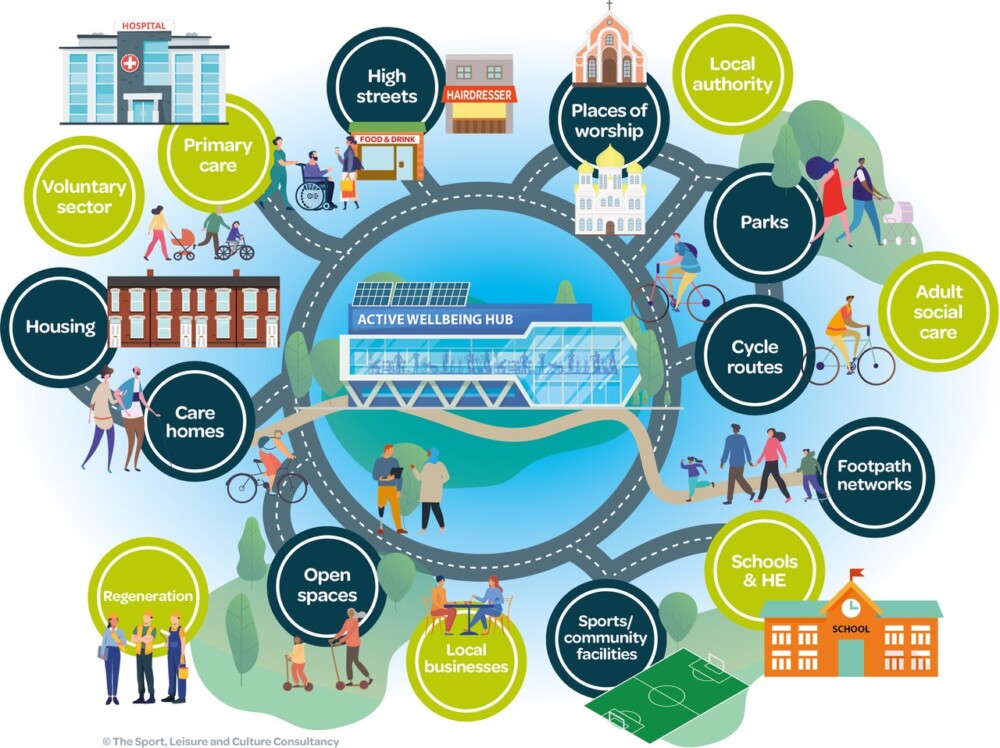In the first of our series of blogs (Pivoting with Purpose) on the pivot to active wellbeing, SLC’s Duncan Wood-Allum urged the public sector to seize the opportunity to improve population health by pivoting its leisure services to active wellbeing.
In this blog, we turn our attention to some of the key early considerations for councils exploring the pivot towards active wellbeing and what this could entail.
The concept of pivot heavily influenced Sport England’s Future of Public Sector Leisure report (Dec 2022). It builds on the ground-breaking Pivot to Active Wellbeing Programme in Greater Manchester (GM) by the GM authorities, GM Active, GM Moving and Sport England but it is still an emerging concept. We currently define it as:
“The transformation of leisure services towards a more integrated health, social care and wellbeing offer.”
It has the potential to enable your leisure services to play a more impactful role in improving population health over time as part of a wider place-based approach. The various assets and organisations in place would together create an active wellbeing ecosystem, as illustrated below.

An active wellbeing ecosystem
For many of our council clients, continuing to provide a traditional leisure service is not an option, for three main reasons:
- Leisure is a non-statutory service and often requires revenue investment. In the current climate it is inevitable that leisure services will be subject to scrutiny, particularly those services with older facilities and higher levels of subsidy. With many councils facing multi-million-pound savings targets, politicians and executive teams have little choice but to consider cutting leisure to protect core statutory services.
- The contribution of a traditional leisure service towards strategic outcomes and social value – health improvement and community development – can be quite limited. This is because it tends to better serve healthier and more active populations. As a result, services are often vulnerable in their current state as councils question their value.
- Leisure services are often only used by a small minority of residents and rarely by the people who would benefit from a more active lifestyle, including those experiencing the worst health inequalities. This makes it harder to protect the service, particularly when resources are diminishing.
Given these circumstances, pivoting to active wellbeing, with services aligned to strategic outcomes and health inequalities in particular, is a compelling alternative to traditional leisure.
Three key considerations
There are three key considerations for those councils thinking about pivoting their leisure services to active wellbeing.
- Transformation needs patience. The transformation journey should be considered as a large-scale service change where the benefits are accrued incrementally over the long-term;
- Partnerships are created and strengthened
- Communities are engaged more regularly
- Trust is built across the system
- New service models are developed
- Facilities can be repurposed.
All of this takes time. Wigan Council, which has been something of a trailblazer for the pivot to active wellbeing, started its journey over 10 years ago with the Wigan Now the council has a well-established wellness service, Be Well, and is considering options to make its leisure facilities much more aligned to delivery of active wellbeing services.
SLC has been supporting North Yorkshire Council to develop a vision and service delivery plan for sport and active wellbeing. This has revealed a need to take a medium to long-term view, supported by a clear vision and strong leadership.
- Collaboration, partnership and trust are required. If we’ve learned anything over the last 10 years, it’s that collaboration and partnership are key to the success of any major transformation programme. There are three main reasons for this:
- Firstly, pivoting is not just about the council’s own services; it is about all aspects of wellbeing across a place
- Secondly, energy and skills exist within the community and if they can be aligned, the capacity to enable authentic, locally co-produced activity increases dramatically.
- Thirdly, partnership working isn’t easy – it requires understanding, empathy, perseverance, flexibility and time. In some cases, it might need new skills and attitudes, and all parties need to be willing to collaborate. In our experience, organisations will only embrace partnership if the benefits are significant and obvious.
- A learning mindset is required. There are at least half a dozen councils already making good progress with their pivot to active wellbeing programmes. Each will have hit bumps in the road but with a clear vision and strong partnerships, they have made real progress. SLC has been able to facilitate conversations and informal connections between these progressive authorities and those who are just starting out, and the learning has proved invaluable.
What are the benefits?
So, what are the benefits that a well-designed, well managed pivot / transformation process can bring over the short- (1-3 years), medium- (3-5 years) and long-term (5 years+)?
Shorter term benefits
- Better alignment with the council’s strategic outcomes. This will help establish active wellbeing as a corporate priority and should provide longer term political commitment and security.
- A renewed strategic approach with stronger monitoring and evaluation of progress towards strategic outcomes. For example, by better articulating the social value generated by a service, partners such as health and social care providers are much more willing to engage. The key here is having robust, credible measures of social value such as the WELLBY, which is recognised by official HM Treasury guidance. This allows officers, members and partners to demonstrate the value of their investment through a measure which can stand up to the toughest scrutiny.
- An enhanced services specification to support delivery partners to sustainably shift the emphasis of service delivery to supporting less active members of the community.
- Better activation of parks, open spaces and community venues to support active wellbeing and informal physical activity. These assets, which are often supported by voluntary, community and social enterprise organisations, can provide high value, lower cost solutions for active wellbeing.
- An investment strategy setting out how built facilities can meet the future needs of a population from a wellbeing perspective by providing a greater range of services and support.
- A review of the local workforce, scoping what opportunities exist to support the workforce to change skills, culture and behaviours to create a more outward facing, responsive and inclusive service in the future.
Medium term benefits
- More engagement by the large proportion of residents who don’t currently use leisure services. Re-designing services to appeal to a broader audience will increase footfall, income and social impact. This is already being witnessed in some councils where the redesigned services are attracting new users from communities that experience inequalities. A well-designed active wellbeing service should have a lower net cost (cashable and non cashable) than a traditional leisure service when considering its ability to deliver social value at a much larger scale than traditional leisure services.
- Leisure facilities which are transformed into community wellbeing hubs that offer services which are more relevant to the needs of their local communities. SLC has worked closely with several councils in exploring how their leisure assets can be transformed into wellbeing assets which play a much stronger placemaking role.
- New, integrated masterplans for parks and open spaces to sustainably optimise their potential to meet a broader range of needs and improve the wellbeing of local communities.
- Trusting relationships with residents, community organisations and delivery partners, working together to develop shared goals and design services for mutual benefit. The benefits of this go way beyond the pivot programme – this is the development of community power, the ability of local communities to take control of their own destinies by focusing on what is important for them. Investing into these future relationships is challenging but worthwhile and will create opportunities for greater collaboration and synergies.
Longer term benefits
- A significant contribution to a reduction in health inequalities. The active wellbeing service’s contribution towards this will be delivered through universal and targeted services as part of a wider whole system approach.
- A sustainable service which is efficient, effective and supported by investment not only from the Council, but from commissions from other strategic partners.
- A service that has deep, trusted connections with its community and its strategic partners in place.
- A responsive place-based workforce that is more diverse, representative of its community and upskilled to support people with long term health conditions and other health inequalities. A workforce that is capable of supporting preventative pathways, prehabilitation and rehabilitation.
 Ready to pivot?
Ready to pivot?
To help councils assess their state of readiness to pivot to active well-being, SLC has developed a proven diagnostic approach. This builds on Sport England’s Strategic Outcomes Planning Guidance tool which SLC helped to develop. It looks at factors such as people and places, strategies, assets, partnerships, skills and leadership. It considers the risks and benefits for a council in understanding its current state and exploring opportunities for the future. Through a combination of desk research, consultation and analysis, we assess what the council and its partners need to do next to embark on a successful pivot programme. We hope this diagnostic is the start of a transformation of your leisure service into a sustainable and impactful active wellbeing service, making a real difference to the health of your local communities.
Don’t just take our word for it
“Overall an excellent experience which delivered a high quality, value for money product. The insight, expertise and wider industry knowledge and good practice was particularly valuable. We enjoyed the collaborative approach and appropriate challenge which really added value to the final outcome. Would not hesitate to recommend.”
Jo Ireland, Assistant Director, Culture, Leisure & Libraries. North Yorkshire Council
If you want to find out more about how we can help you explore your pivot to active wellbeing, please contact the SLC team at info@slc.uk.com or call 01444 459927 www.slc.uk.com

